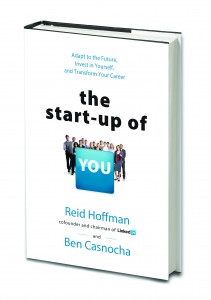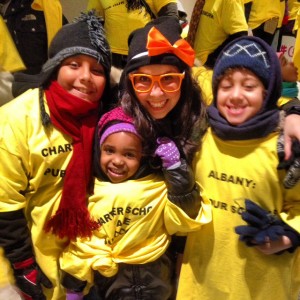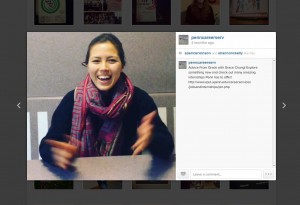by Ana Schwartz
New Semester, Looking Ahead
OCR has already started and even for those students who aren’t seniors, this means a serious look ahead to life beyond these years in the university. Career Services offers a great diversity of resources to help prepare for that new world, but sometimes the most intimidating challenges are intimidating because they aren’t exactly specific, because they can’t be quite precisely identified, but they nevertheless haunt the more or less eagerly anticipated adult life in ways for which even the most proactive student can’t quite prepare. One hypothesis for this malaise: what happens to all my friends when we all have different jobs? The past several years as a graduate student, particularly in a field that requires such solitary work as the humanities, have offered a middle stage between the highly social, deliberately collaborative work of undergrad and the more specialized, often more lonely work of the adult. In this context, a book like The Startup of You, Reid Hoffman and Ben Casnocha’s slim, but powerful career advice manual, seemed like it would be a pleasant way to imagine the experience of friends in the Engineering and Business disciplines. It turned out to have surprisingly valuable insights into other fields as well. Specifically, their insistence on more mindful social activity can supplement the professional life of advanced students and recent graduates, but it can also help smooth the transition.

Reframe Your Career Narrative
The book begins with a bit of a scare: The occupational environment college graduates can expect to enter looks bleak. The world of work is changing. In the first pages, Hoffman and Casnocha present a crucial distinction and a memorable metaphor to give it impact: One primary characteristic of the new occupational landscape is the distinction between “labor” and “entrepreneurship,” an insight made more clear by the rise of Startup Culture. Mere labor is “working hard.” Entreprenurship is “working smart.” It’s no longer enough, they contend, just to work hard. The job market is an escalator, now jammed, and it’s no longer possible to ride mindlessly to the top, as it might have been for prior generations. Although both of the authors have a lot of experience with startups, they stretch the boundaries of startup thinking beyond the literal entrepreneurship world. For them, instead, it’s a perspective, a mentality of “permanent beta,” demanding on one hand, persistent flexibility, as well as rigorous personal accountability.
“Permanent Beta”
But these authors’ unique experience in the Silicon Valley isn’t negligible. It offers them historical perspective, forward-thinking best practices, as well as undergirds their exemplary collaborative relationship. For the authors, the Silicon Valley’s parallels the rise of Detroit in the post-war American economy, and such a comparison gives a sense of the high stakes of startup thinking: Always think ahead. This is “permanent beta.” Given the tech innovation of the Silicon Valley, it’s tech tools and resources that will make the proactive entrepreneurial thinker successful. In particular, the authors plug use of platforms like LinkedIn, since, Reid Hoffman, of course, is the founder. Yet, given this inevitable emphasis, his insights are surprisingly profound. He’s less interested in the minutiae so much as offering a more expansive representation of the aims and ends of the platform. The premise that undergirds LinkedIn—that it’s not what you know, but who you know—is valuable not only for a career, but for a fulfilled and satisfied life. Thus, even in writing a book, it’s important for Hoffman to collaborate; Casnocha, author, venture capitalist, and social luminary is the perfect colleague. Together they use the insights of the past to anticipate tomorrow, but in the smartest and most dynamic company. This is the lesson that this book comprehensively describes as well as performs.
Best Practices
But, like any business, students, even the most organized and proactive, have limited resources of time and attention. Hoffman and Casnocha acknowledge these limits. Even their most concisely vivid piece of advice: “One lunch is worth one thousand emails” has a sobering inverse: Only lunch with those whom you might imagine sending that many emails. This isn’t a snub. But face time is valuable, and it’s relative. In these insights, their book offers a perspective on social and professional life that helps prioritize the powerful resources available to students—knowledge, enthusiasm and passions, and above all, social connections. Some of the more memorable, and actionable pieces of advice for students are the following:
- Use social media for better self-understanding. Digital platforms can serve as a personal archive, especially for the younger generation, who have slipped more fluidly into comprehensive digital self-representation. Personal archives—the history of tweets, status updates, shared articles—offer insights into patterns and priorities and can guide students to discovering their most powerful passions and interests. Search your email and twitter feed to find the themes that you keep returning to, as well as your best interlocutors. Pursue those interests and nurture those alliances.
- Use social media to practice dialogue. “Ask better questions,” Hoffman and Casnocha advise, and platforms like LinkedIn or Twitter allow great experimentation for framing questions to get the most useful answers, relative to the situation. Twitter, for example, is a great resource for quick, concise conversation: it can swiftly disseminate queries and responses, citations and elaborations. LinkedIn, on the other hand, encourages and showcases longer, more thoughtful conversation. Sometimes a quick response is more valuable than a longer prose account; sometimes not. Practicing skillful inquiry on both these platforms can help to identify conversational goals and make these skills reflexive.
- Use social media to “Learn when to Let Go.” The authors specifically direct this advice to young people, and it has special traction for a college readership. They observe that one value of college is the time and proximity that structures social discovery and intellectual collaboration. These are vital to future success. But transitioning into a career in the professional world brings graduates to a social bottle-neck and it can be difficult to maintain all of these relationships at the same caliber, still more difficult to deliberately sever these ties. They by no means advocate ending friendships, but rather encourage students to identify which friends are the most valuable company—which inspire you, stimulate you, which encourage to better and more interesting work. These are the relationships to actively cultivate. Not at the expense of the others—and this is where the various platforms of social media can be valuable. Instead, sustain acquaintances and less important alliances through venues like Facebook or Instagram, so that, if the opportunity for renewed collaboration appears, you’ll be ready to seize it.
The Quaker Connection
In 1727, four years after arriving in Philadelphia, a twenty-one year old Benjamin Franklin started “The Junto,” a conversational club among his colleagues in the up-and-coming new urban community. They met on a regular basis to talk about their ideas, their readings, their innovations and plans for the city—ideas that, over time, would come to influence Franklin in his contribution to the founding of the United States. It’s no accident that, almost three hundred years later, the social group founded by Ben Casnocha in the South Bay would take the name “The Junto.” He, along with other citizens of the Silicon Valley see themselves as the inheritors of a historical trajectory that students at Penn here also claim. Social Media is one very powerful tool to claim that future together.






